The history of the Royal Canadian Navy goes back to 1910, when the naval force was created as the Naval Service of Canada and renamed a year later by King George V. The Royal Canadian Navy (RCN) is one of the three environmental commands of the Canadian Forces. Over the course of its history, the RCN has played a role in the First World War, contributed significantly to the Battle of the Atlantic during the Second World War, and was a part of NATO's force buildup during the Cold War. In 1968, the RCN was amalgamated with the Canadian Army and the Royal Canadian Air Force to form what is today the unified Canadian Armed Forces. The naval force was known as Maritime Command until 2011, when the environmental command was renamed as the Royal Canadian Navy.
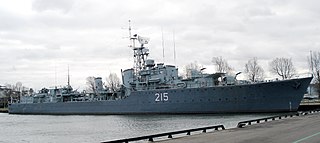
HMCS Haida is a Tribal-class destroyer that served in the Royal Canadian Navy (RCN) from 1943 to 1963, participating in World War II and the Korean War. She was named after the Haida people Haida was inspected by commissioner for Canada Vincent Massey shortly after her commissioning in 1943.

The Flower-class corvette was a British class of 294 corvettes used during World War II by the Allied navies particularly as anti-submarine convoy escorts in the Battle of the Atlantic. Royal Navy ships of this class were named after flowers.

HMCS Rimouski was a Royal Canadian Navy Flower-class corvette which took part in convoy escort duties during the Second World War. She fought primarily in the Battle of the Atlantic. She was named after Rimouski, Quebec.
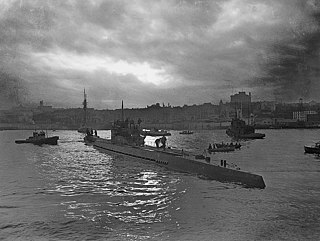
The Battle of the St. Lawrence involved marine and anti-submarine actions throughout the lower St. Lawrence River and the entire Gulf of Saint Lawrence, Strait of Belle Isle, Anticosti Island and Cabot Strait from May–October 1942, September 1943, and again in October–November 1944. During this time, German U-boats sank over 20 merchant ships and four Canadian warships. There were several near-shore actions involving the drop of German spies, or the attempted pickup of escaping prisoners of war. Despite the 23 ships lost, this battle marked a strategic victory for Canadian forces as ultimately they managed to disrupt U-boat activity, protect Canadian and Allied convoys, and intercept all attempted shore operations. This marked the first time that a foreign power had inflicted casualties in Canadian inland waters since the US incursions in the War of 1812.

HMCS Alberni was a Flower-class corvette that served in the Royal Canadian Navy (RCN) during the Second World War. The Flower-class corvettes were warships designed for anti-submarine warfare. The ship was constructed by Yarrows Ltd. in Esquimalt, British Columbia, laid down on 19 April 1940, launched on 22 August and commissioned on 4 February 1941. The corvette sailed east to join the RCN's fleet in the Atlantic via the Panama Canal, where upon arrival, the vessel began escorting trans-atlantic convoys in the Battle of the Atlantic. Alberni took part in the key convoy battle of Convoy SC 42. In 1942, the corvette was transferred to Allied convoy assignments associated with Operation Torch in the Mediterranean Sea. In 1944, Alberni was among the Canadian naval vessels assigned to Operation Neptune, the naval component of the invasion of Normandy and escorted support ships to and from the United Kingdom on D-day.

HMCS Skeena was a River-class destroyer that served in the Royal Canadian Navy (RCN) from 1931 to 1944. She was similar to the Royal Navy's A class and wore initially the pennant D59, changed in 1940 to I59.
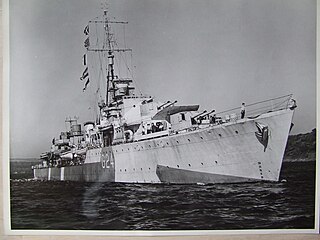
HMCS Huron was a Tribal-class destroyer that served in the Royal Canadian Navy in the Second World War and the Korean War. She was the first ship to bear this name, entering service in 1943. She was named for the Huron people. During the Second World War the vessel saw service in Operation Neptune in the Bay of Biscay and along the French coast in support of the invasion of Normandy and escorted convoys to the Soviet Union. Following the war, the ship was placed in reserve. The destroyer was activated in 1950 as a training ship, but with the onset of the Korean War, was modernized and deployed twice to Korea. Following the war, Huron reverted to a training ship and took part in Cold War-era North Atlantic Treaty Organization (NATO) naval exercises until being paid off for the final time in 1963 and broken up for scrap in 1965.

Vice Admiral Henry George DeWolf was a Canadian naval officer who was famous as the first commander of HMCS Haida during the Second World War.

The River class was a series of fourteen destroyers of the Royal Canadian Navy (RCN) that served before and during the Second World War. They were named after Canadian rivers.

HMS Fortune was one of nine F-class destroyers built for the Royal Navy in the mid-1930s. Although she was assigned to the Home Fleet upon completion, the ship was detached to the Mediterranean Fleet to enforce the arms blockade imposed by Britain and France on both sides during the Spanish Civil War of 1936–39. Several weeks after the start of the Second World War in September 1939, Fortune helped to sink a German submarine. The ship escorted the larger ships of the fleet during the early stages of World War II and played a minor role in the Norwegian Campaign of 1940. Fortune was sent to Gibraltar in mid-1940 and formed part of Force H where she participated in the Battle of Dakar against the Vichy French. The ship escorted numerous convoys to Malta in 1940–41 until she was badly damaged by Italian bombers in mid-1941.

HMS Foxhound was one of nine F-class destroyers built for the Royal Navy in the mid-1930s. Although she was assigned to the Home Fleet, the ship was detached as part of the Mediterranean Fleet to enforce the arms blockade imposed by Britain and France on both sides during the Spanish Civil War of 1936–39. Several weeks after the start of the Second World War in September 1939, Foxhound helped to sink a German submarine and participated in the Second Battle of Narvik during the Norwegian Campaign of April–June 1940. The ship was sent to Gibraltar in mid-1940 and formed part of Force H where she participated in the attack on Mers-el-Kébir. Foxhound escorted the aircraft carriers of Force H as they flew off aircraft for Malta and covered convoys resupplying and reinforcing the island until late 1941. During this time the ship helped to sink another German submarine.
Vorpostenboot, also referred to as VP-Boats, flakships or outpost boats, were German patrol boats which served during both World Wars. They were used around coastal areas and in coastal operations, and were tasked with – among other things – coastal patrol, ship escort, and naval combat.
Convoy SC 42 was the 42nd of the numbered series of World War II Slow Convoys of merchant ships from Sydney, Cape Breton Island to Liverpool. SC 42 was attacked over a three night period in September 1941, losing 16 ships sunk and 4 damaged. This was the worst Allied loss following the attack on convoy SC 7 the previous year. Two attacking U-boats were destroyed.

Convoy ON 154 was a North Atlantic convoy of the ON convoys which ran during the battle of the Atlantic in the Second World War. It was the 154th of the numbered series of merchant ship convoys Outbound from the British Isles to North America. It came under attack in December 1942 and lost 13 of its 50 freighters; one U-boat was sunk.
SC 48 was a North Atlantic convoy of the SC series which ran during the battle of the Atlantic in World War II.

HMS Comet was a C-class destroyer built for the Royal Navy in the early 1930s. She saw service in the Home and Mediterranean Fleets and the ship spent six months during the Spanish Civil War in late 1936 in Spanish waters, enforcing the arms blockade imposed by Britain and France on both sides of the conflict. Comet transferred to the Royal Canadian Navy (RCN) in 1938 and renamed HMCS Restigouche. During World War II, she served as a convoy escort in the battle of the Atlantic, on anti-submarine patrols during the invasion of Normandy, and was employed as a troop transport after VE Day for returning Canadian servicemen, before being decommissioned in late 1945. Restigouche was sold for scrap in 1946.
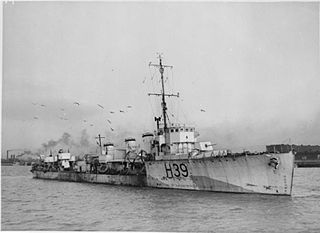
An Escort Group consisted of several small warships organized and trained to operate together protecting trade convoys. Escort groups were a World War II tactical innovation in anti-submarine warfare by the Royal Navy to combat the threat of the Kriegsmarine's "wolfpack" tactics. Early escort groups often contained destroyers, sloops, naval trawlers and, later, corvettes of differing specifications lacking the ability to maneuver together as a flotilla of similar warships, but rigorously trained in anti-submarine tactics to use teamwork emphasizing the unique sensors, weapons, speed, and turning radius of each ship. The development of these 'escort groups' proved an effective means of defending shipping convoys through the Battle of the Atlantic.
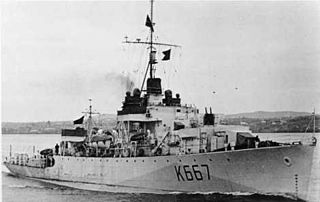
HMCS Inch Arran was a River-class frigate that served with the Royal Canadian Navy during the Second World War and again from 1954 to 1965, when she was converted into a Prestonian-class frigate. She was named after Inch Arran Point in Dalhousie, New Brunswick, Canada. This was due to the inability of two Allied warships to bear the same name. The RCN would then use landmarks or significant areas that were associated with the community instead.
German submarine U-741 was a Type VIIC U-boat built by F Schichau GmbH of Danzig and commissioned on 10 April 1943.













